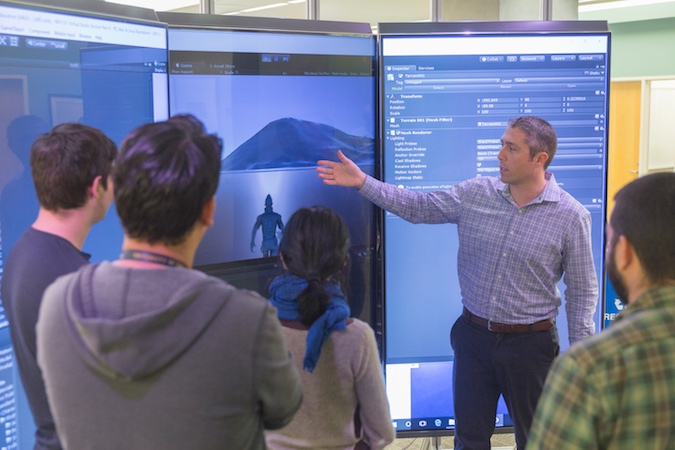
is leading his students on a tour of Palenque, the ancient Mesoamerican city that flourished at the peak of Maya civilization. They’re exploring the altar atop the Temple of the Cross, inspecting it from all angles and scrutinizing every detail.
But they’re not in Mexico. Lercari and his students are on the second floor of the UC Merced Library, standing before a triptych of high-definition monitors, which they view through 3-D glasses. Lercari navigates the first-person, 360-degree panoramic tour using an Xbox controller. Passers-by stop to ask questions.
“It’s a new class,” explains teaching assistant Anais Guillem. “World Heritage 110: 3-D Modeling Cultural Heritage. And this is the LibraryCAVE.”
The LibraryCAVE is a smaller version of UC Merced’s Wide-Area Visualization Environment (WAVE) system, a 20-screen VR multiplex that allows researchers to navigate interactive 3-D renderings of complex structures. The WAVE is a powerful tool that can be used to explore ancient ruins or visualize the inner structure of the brain.
With only three screens, the LibraryCAVE is more compact but no less impressive. It can do much of what the WAVE does, but it serves a different purpose. Whereas the WAVE is primarily a research tool, the LibraryCAVE is meant to serve as a teaching tool. As such, it’s housed in full view of the public, en route to the library’s second floor stacks.
Though it’s only been up and running since last summer, Lercari has already incorporated the LibraryCAVE into World Heritage 110, part of the new World Heritage minor that SSHA instituted just this year. Though the course teaches students standard techniques in archaeological analysis — including methods for finding, reconstructing and interpreting historical sources — thanks to the LibraryCAVE, it also incorporates computer-aided design techniques more commonly associated with architecture and engineering.

“We wanted an interactive virtual studio session like at architecture schools,” Lercari said. “Students present their work and have faculty and students comment on it.”
Over the course of the semester, Lercari asks his students to complete three projects of increasing complexity using Autodesk 3ds Max, a software platform widely-used for 3-D graphics. The students create 3-D models of Palenque’s Temple of the Cross and present their renderings on the LibraryCAVE, receiving feedback from Lercari to help them improve their digital drafting skills.
The LibraryCAVE is one of four CAVE kiosks in the UC system. Others are located at UC Berkeley’s Hearst Museum, UC San Diego’s Geisel Library and UCLA’s Fowler Museum. All four installations are part of the “At-Risk Cultural Heritage and the Digital Humanities” project, funded by a 2016 UC President’s Research Catalyst Award. According to the project abstract, its aim is “to use cyber-archaeology and digital humanities to document and safeguard virtually some of the most at-risk heritage objects and places.“
But the LibraryCAVE is also part of a broader trend reflecting the evolving role of libraries in the digital age.
“There’s lots of movement to digital and technological innovations happening in libraries nationwide,” University Librarian Haipeng Li said. “Libraries, particularly academic libraries, are changing from the traditional role of keeping books to broader roles that support teaching, research and learning. In the U.S., academic institutions are designing library spaces driven by technology to support these expanded roles.”
The library already offers digital curation and scholarship services. They also administer the Spatial Analysis and Research Center (SpARC) , which consults on projects related to spatial data management, cartography and web mapping.
“In the future, we hope for an expanded role in data management,” Li said. “Data management is what librarians are good at.”
Though World Heritage 110 is the first class to employ the LibraryCAVE, both Lercari and Li look forward to helping other faculty incorporate it into their own syllabi.
“We wanted to make sure that it works for classes,” Li said. “This semester is like a pilot run. If successful, we can push the CAVE to other faculty who might find it useful.”


